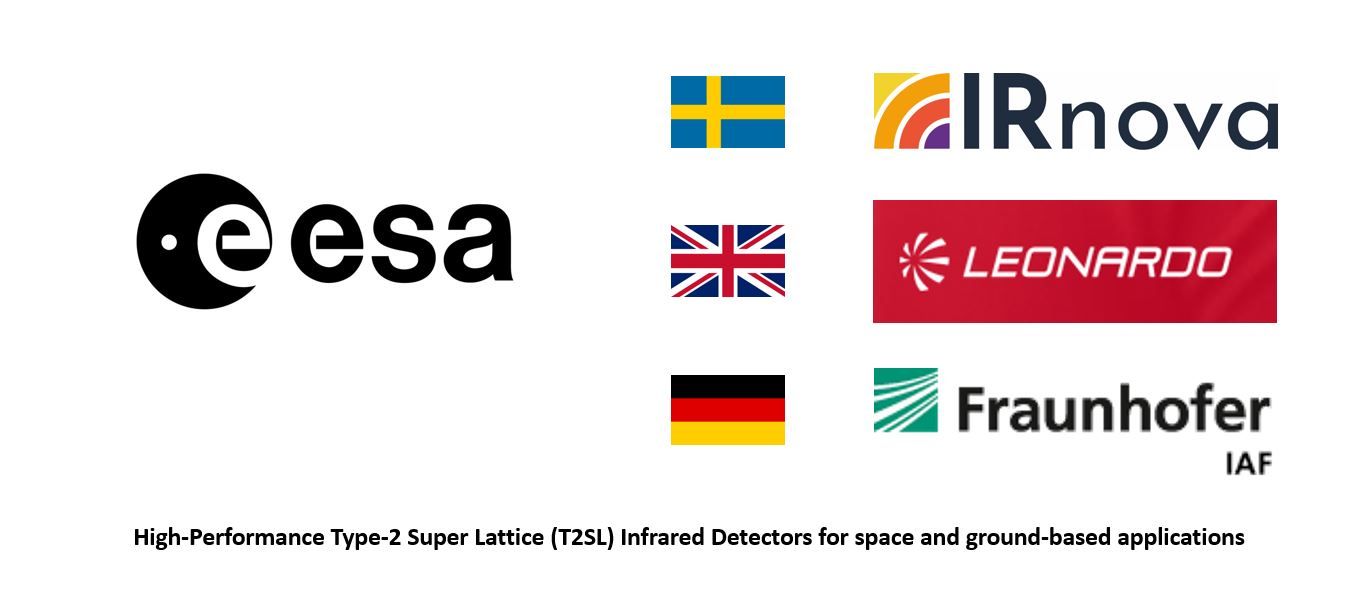ESA contract award for High-Performance Type-2 Super Lattice (T2SL) Infrared Detectors
The European Space Agency (ESA) and a European consortium comprised of IRnova AB (Sweden) as the contract leader, Leonardo UK (United Kingdom) and Fraunhofer IAF (Germany), announced the final agreement and contract signature for the development of High-performance Type-2 Super Lattice (T2SL) infrared detectors intended for future space and ground-based applications.
Several primary objectives will be pursued, including to demonstrate a reliable process for producing large format T2SL infrared detectors (Arrays > 1 K x 1 K pixels, 10 µm pitch) meeting ESA electro-optical specifications, validate high-quality substrates grown in Europe and qualify a full-European supply chain for T2SL up to TRL6. Within this consortium led by IRnova AB, each partner will bring their state-of-the-art capabilities for custom ROIC design, T2SL epi structure design, Epitaxial layer growth and large focal plane /small pitch hybridization processes.
This contract reiterates the maturity of T2SL and the willingness from ESA to maintain European sovereignty in state-of-the-art infrared detector supply chain to cover for future needs.
T2SL technologies are being investigated to facilitate lower resource detector operation at longer wavelengths and higher temperatures. T2SL is recognised as the most promising alternative to MCT for 2D Long Wave Infra-Red (LWIR) and Very Long Wave Infra-Red (VLWIR) arrays. This material structure offers great flexibility on tailoring the bandgap (cut-off wavelength) to any desired detection wavelength in the infrared wavelength region. By individually varying the thickness and composition of the alternating layers in the lattice structure, detectors covering from short wavelength infra-red (SWIR, 0.9 -2.5 µm) to very long wavelength infra-red (VLWIR, 10.5-16 µm), can be manufactured.
About IRnova AB
IRnova AB is a Swedish independent company, supplying high-end cooled infrared detectors based on T2SL and QWIP technologies. IRnova has pioneered T2SL advancements in Europe, several products have successfully entered serial production for both industrial and defence applications. More recently, key milestones were achieved for SWaP infra-red detector using HOT MWIR structures for mobile/portable and battery powered EO systems.
About Leonardo UK
Leonardo is one of the UK’s leading aerospace companies and one of biggest suppliers of defence and security equipment to the UK MoD, making a significant contribution to the UK economy with revenues of over £2bn, around 50% of which are in export. Leonardo’s InfraRed (IR) detectors and Thermal Imaging (TI) sensors, manufactured at the company’s Southampton and Basildon sites, play a crucial role in supporting military, security and civil clients operating in the most challenging environments worldwide. IR detectors and TI sensors are at the heart of Leonardo’s Electro-Optical/Infra-Red (EO-IR) systems, used in many sensing applications such as: Thermal Imaging Land, Naval and Airborne Systems; Missile Guidance; Space and Astronomy Instruments
About Fraunhofer IAF
The Fraunhofer Institute for Applied Solid State Physics IAF is one of the world’s leading research institutions in the fields of III-V semiconductors and synthetic diamond. Fraunhofer IAF has been the first institution in Europe to demonstrate the large potential of T2SL technology for infrared imaging applications. To provide an industry-compatible T2SL technology, Fraunhofer IAF has established the complete chain for detector array fabrication including design and modelling, epitaxial growth, as well as front- and backside processing.
About ESA
The European Space Agency (ESA) provides Europe’s gateway to space.
ESA is an intergovernmental organisation, created in 1975, with the mission to shape the development of Europe’s space capability and ensure that investment in space delivers benefits to the citizens of Europe and the world. ESA has 22 Member States: Austria, Belgium, the Czech Republic, Denmark, Estonia, Finland, France, Germany, Greece, Hungary, Ireland, Italy, Luxembourg, the Netherlands, Norway, Poland, Portugal, Romania, Spain, Sweden, Switzerland and the United Kingdom. Slovenia, Latvia and Lithuania are Associate Members. ESA has established formal cooperation with six Member States of the EU. Canada takes part in some ESA programmes under a Cooperation Agreement.
By coordinating the financial and intellectual resources of its members, ESA can undertake programmes and activities far beyond the scope of any single European country. It is working in particular with the EU on implementing the Galileo and Copernicus programmes as well as with Eumetsat for the development of meteorological missions.
Read the press release of IRnova here: ESA contract award for High-Performance Type-2 Super Lattice (T2SL) Infrared Detectors
The use of the photos is permitted exclusively in connection with this press release and under indication of the copyright.
Last modified:
 Fraunhofer Institute for Applied Solid State Physics IAF
Fraunhofer Institute for Applied Solid State Physics IAF